How Google Indexing Impacts Instagram Content: What Marketers Need to Know
As of July 10, 2025, Instagram announced a game-changing update: all public professional accounts (business and creator profiles) are now automatically indexed by search engines like Google and Bing. In other words, your Reels, captions, carousels, bios, and even alt text can now appear directly in search results. This update retroactively applies to content dating back to January 2020.
For marketers, the implications are huge. Understanding how Google indexing impacts Instagram content is essential for shaping future social media and SEO strategies.

Digital Marketing
Capture Leads, Generate Sales & Find New Customers
Capturing relevant information about customers, fans, followers, and friends enable us to create more personalized interactions. In turn, we can better understand how to provide the best possible experience for our target audience.
Why This Change Matters
Instagram has traditionally been a closed platform, with discoverability limited to the app itself. Now, by making posts searchable beyond the feed, Instagram content transforms into a long-term digital asset. For brands, this means:
- SEO Value for Social Posts: Captions, bios, hashtags, and alt text now play a role in how search engines rank and surface your content.
- Extended Reach: Posts are not just for followers anymore, they can reach high-intent audiences searching on Google.
- Competitive Advantage: Instagram joins YouTube and TikTok as a key player in the search ecosystem, leveling the playing field for visual-first content.
What This Means for Your Brand
This shift turns every Instagram post into a potential landing page. To stay competitive, brands should:
- Optimize Captions Like Metadata: Treat the first line of your caption as a headline. Include relevant, natural keywords that connect with both search intent and your audience.
- Revisit Your Bio: Think of your bio as a mini-webpage. Use keyword-rich descriptions that clearly communicate your services, location, and industry.
- Leverage Alt Text: Alt text is not just for accessibility, it is now a discoverability tool. Write descriptive, keyword-informed alt text that helps search engines (and users) understand your content.
- Audit and Update Old Content: Since indexing goes back to 2020, revisit past high-performing posts. Update captions, hashtags, and alt text to align with your current SEO strategy.
- Collaborate Across Teams: Social media and SEO teams need to align more closely than ever. Shared keyword research, content calendars, and cross-platform strategies will maximize performance.
The Privacy Factor
Not every brand will want its Instagram content searchable outside the app. In those cases, Instagram provides control. Professional account holders can opt out by going to:
Settings > Privacy > “Allow public photos and videos to appear in search engine results.”
This toggle gives brands flexibility to manage their digital footprint without abandoning Instagram’s new opportunities.
Capturing relevant information about customers, fans, followers, and friends enable us to create more personalized interactions.
Looking Ahead: Social SEO as Core Strategy
The update is more than just a feature, it is a redefinition of how brands use Instagram. By embracing how Google indexing impacts Instagram content, marketers can move from short-term engagement to long-term discoverability. Social content now carries weight far beyond the scroll, acting as a sustainable driver of organic traffic and brand awareness.
If you are ready to strengthen your digital presence and align your Instagram strategy with SEO best practices, the team at Kraus Marketing is here to help. Contact us today to start building content that performs on both social and search.

